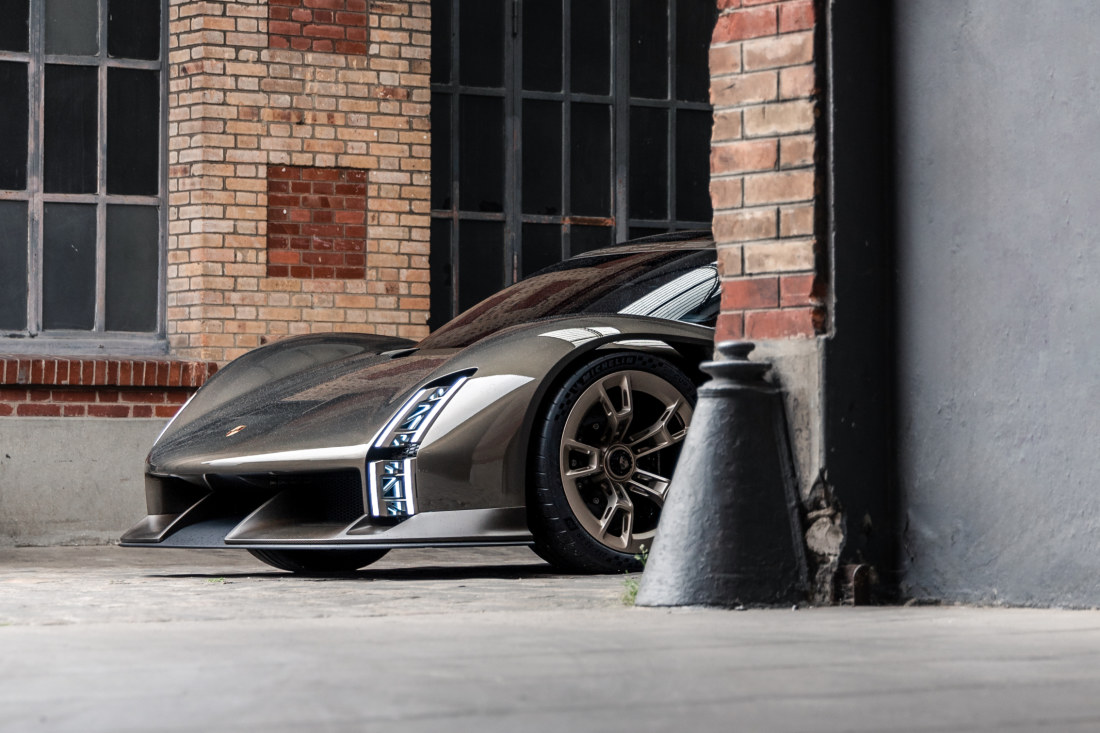The Porsche Australians will go nuts for – if it’s ever made
The radical new Mission X concept sports car is primed to break records should it go into production.
“Being responsible for the design of Porsche is a real dream job,” says Michael Mauer, head of the company’s style department. “And whenever you get as a designer the opportunity to design a concept car, I would say that’s like the icing on the cake.”
Mauer is talking at the Stuttgart launch of Porsche’s Mission X sports car, and he stresses it’s not just the all-electric drivetrain that points to Porsche’s future. It’s the lack of self-driving technology.
“We believe the last car that will have a steering wheel is most likely a Porsche, so all the necessary buttons and things that the driver needs are very nicely arranged around the driver.”

The Mission X has been in high demand since the first photos were released.
On the other side of the world, moments after photos of the Mission X appeared online, Daniel Schmollinger’s phone started ringing. Schmollinger is the chief executive officer of Porsche Cars Australia and his top customers were breaking the rules and phoning the boss direct, rather than their dealer. Never mind that none had seen the Mission X in the flesh, nor been given the specifications or price, much less a chance to drive it.
They wanted a place in the queue. It happens every time Porsche unveils something special, says Schmollinger. “But the feedback for this has been overwhelming.”
Officially, the Mission X is a concept, or show car, built to celebrate Porsche’s 75th anniversary as a car maker. It’s clearly inspired by Le Mans racing cars, with lift-up doors and a body just 1.2 metres tall. Porsche, via a company statement, says if it were to go into series production, it would be to “create the fastest road-legal car on the Nurburgring Nordschleife”.

The Mission X has a 900-volt electrical system that will charge twice as quickly as the Taycan’s, says Porsche.
As design briefs go, that’s pretty niche. The Nordschleife, or northern loop, of Germany’s historic Nurburgring racetrack consists of 20.832 kilometres of crests, dips, climbs and ever-changing surfaces. It runs through the forests of the Eifel mountains and its treacherous nature, and high fatality rate, led British Formula 1 champion Jackie Stewart to dub it “the Green Hell”.
Yet because of its unique challenges, the ’Ring is increasingly being used by car makers to promote their sporting credentials.
The fastest single lap by an all-electric road car has bounced between Tesla (with its Model S Plaid) and Porsche (the Taycan Turbo sedan). But with its Mission X, Porsche isn’t talking about the all-electric record but the outright one.
That’s now 6 minutes, 35.183 seconds and is held by the Mercedes-AMG One, a road-going coupe with an F1 hybrid drivetrain. The Mercedes averaged about 190km/h over the whole lap and hit a top speed of 338km/h.

The spring 2023 issue. Joann Pai
So will the X go into production and fulfil its Green Hell mission? Schmollinger says he can’t possibly comment, then adds with a laugh: “I hope so . . . It would be absolutely amazing.”
There’d be no problem selling it here. Australians buy top-end Porsche models at double the international average (as a proportion of the brand’s overall sales). The same is true with other premium sports car brands here. “This is what makes Australia so special,” says Schmollinger. “Australia is an enthusiast market.”
A previous Porsche concept, known as the Mission E, became the Taycan and has exceeded sales expectations in almost every market (although the finished form was toned down from the original). It’s plausible the Mission X will follow a similar path, though it would be a much lower-volume, higher-priced offering.

The sports car’s cockpit.
Schmollinger says Mission X highlights that Porsche is moving towards widespread electrification. “Our global strategy is, by 2030, we want to have 80 per cent of our whole range electrified. Electrification is our future, there’s no way around that. And the same holds true for Australia.
“We have launched Taycan with a huge success and the electric Macan [SUV] is coming next year. Already there we have the phone ringing with customers asking ‘when can we sign an order?’ Then we have the electric two-door sports car.”
This is based on the 718 series, which comprises the Cayman coupe and Boxster convertible, and is likely to be unveiled next year or in early 2025. The iconic 911 series will continue longer with internal combustion than other models, possibly using a sustainable e-fuel in its rear-mounted, horizontally opposed piston engine.
A Porsche spokesman says the Mission X has a 900-volt electrical system that will charge twice as quickly as the Taycan’s. The battery pack – the heaviest part of an electric car – is installed behind the two-seat cockpit to “centre the mass”, in the hope of giving it the agility of a traditional mid-engined petrol car.

“We believe the last car that will have a steering wheel is most likely a Porsche,” says head of style Michael Mauer.
The company has offered no other technical details, nor revealed how many motors the newcomer will have, but says it’s aiming for one metric horsepower per kilogram. That’s vastly superior to the record-holding Mercedes-AMG, despite the substantial weight penalty that EVs usually carry.
The cockpit has differing colourings from side to side, and a racing-style open-top steering wheel. A suite of cameras is fitted to record your hot laps, while digital and analogue stopwatches enable the second occupant to act as the co-driver in, say, a tarmac rally. Wind tunnel tests indicate the bodywork will achieve greater downforce than the current 911 GT3 RS. That should help plant it firmly through the Nurburgring’s 73 corners.
Does Schmollinger have any doubts a production version could take the record? “Well, if Porsche makes such a statement, they think twice before they do. Having driven all our electric cars that we currently have, knowing our history with motorsport and what it means in terms of performance, and that we know the Nordschleife like our living room, I have no doubt that this will come true.”
The spring issue of Fin Magazine is out on Friday, August 18 inside The Australian Financial Review.
Introducing your Newsfeed
Follow the topics, people and companies that matter to you.
Find out moreRead More

Latest In Cars, bikes, boats
Fetching latest articles